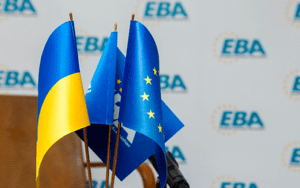
By the end of 2021, another 17 million doses of the American Pfizer vaccine will arrive in Ukraine, Chief State Sanitary Doctor of Ukraine Ihor Kuzin said in an interview with Radio Liberty on Saturday.
“By the end of the year, Ukraine will receive another 17 million of Pfizer,” he said.
At the same time, Kuzin stressed that the coronavirus outbreak may occur earlier this vaccine reaches the country. Therefore, the chief state sanitary doctor of Ukraine does not advise waiting for the opportunity to choose, but getting vaccinated as soon as possible with the vaccine that is available now.
Earlier it was reported that as of August 7, more than 4 million people were vaccinated in Ukraine.

Grain crops traffic on the Dnipro River in January-July 2021 decreased by 23.8% compared to the same period in 2020, to 1.19 million tonnes, the total cargo traffic on the river increased by 38.7%, to 6.5 million tonnes, the river information service of the state-owned enterprise Delta-Pilot (Mykolaiv) said on its website last week.
According to the service, construction materials traffic over the specified period doubled, to 4.66 million tonnes, metal products traffic decreased 15.7%, to 733,000 tonnes.
In general, in January-July 2021, 7,803 trips were made on the Dnipro River, which is 58.4% more than in the same period in 2020.
Delta-Pilot is a branch of the state-owned enterprise Ukrainian Sea Ports Authority (USPA). The river information service of the enterprise provides data on navigation, the state of navigable inland waterways of Ukraine, as well as factors affecting navigation conditions in the area of operation of the service on the Dnipro and Danube rivers.

Attempts by the authorities to limit the list of places for the sale of alcohol and tobacco products, contained in bill No. 5805, registered on July 19 by MP Heorhiy Mazurashu (Servant of the People faction), will lead to an increase in the price of these products, and create additional financial burden for business, therefore it should be rejected, the European Business Association (EBA) said on its website on Friday.
According to the explanatory note to the document, the bill proposes to limit the sale of beer (except non-alcohol), alcohol, low-alcohol beverages, table wines, tobacco products, electronic cigarettes, liquids used in electronic cigarettes, devices for consuming tobacco products without heating them only to specialized fixed outlets (shops) where no other goods are sold than those listed above.
The association noted that this legislative initiative will require capital investments from businesses to equip separate sales outlets, which will lead to an increase in the price of legal products and an increase in the price gap between counterfeit and legal goods.
In this regard, the EBA appealed to parliamentarians with a request not to support such amendments and to reject bill No. 5805 during consideration.
“The number of official sales outlets may significantly decrease, or even disappear altogether, and thus encourage the consumption of counterfeit products. Questions are also raised about the timing of the proposed amendments. It is envisaged that the law will enter into force on the next day after its publication. Since it is physically impossible to create a place of trade in one day, this will stop the sale of alcohol and tobacco products in Ukraine for a long time,” the association said.
The EBA also notes that the proposed amendments may limit competition between business entities in the Ukrainian market. According to it, in most EU countries, there is no such experience of restricting trade in alcohol and tobacco products. In addition, there are no separate rules for regulating the sale of alcohol and tobacco products in public catering establishments.
“The bill does not take into account an assessment of financial and economic consequences of the introduction of such amendments for business and the state, for example, budget losses from a decrease in the number of licenses for retail trade in tobacco and alcohol products,” Svitlana Mykhailovska, the EBA Deputy Director for Advocacy, said.
According to her, the EBA shares the desire of the MP to minimize the impact of binge drinking and smoking on the nation’s health, but the proposed method is selective and inconsistent. In addition, the association did not see in the context of bill No. 5805 an analysis of law enforcement practice and statistical data, which would indicate the ineffectiveness and insufficiency of existing restrictions and bans on the sale of alcohol beverages and tobacco products.

Ukrainian athlete Yaroslava Mahuchikh has won a bronze medal in the high jump at the 2020 Olympic Games in Tokyo.
The 19-year-old Ukrainian has showed a result of 2.00 m.
Three-time world champion Russian Mariya Lasitskene has won with a result of 2.04 m, and Nicola McDermott has showed a result of 2.02 m.
Two other Ukrainian jumpers Iryna Gerashchenko and Yulia Levchenko have taken 4th and 8th places, respectively.
The Olympic Games in Tokyo are held from July 23 to August 8. The Ukrainian team has already won 18 medals: one gold, five silver and 12 bronze medals.

Former player and coach of Dynamo Sergey Rebrov will become a new coach of the Ukrainian national football team, he will be appointed on August 9, according to sports media outlets.
According to Sport.ua, sources at the House of Football have confirmed the relevant information.
“The 47-year-old mentor has agreed to break a contract with Al-Ain Football Club and will be presented as the coach of the Ukrainian national team on Monday,” the edition writes.
It is also noted that Rebrov will sign a contract according to the “2 + 1” scheme and will lead the “blue-yellows” in the selection for the World Cup 2022 and the European Football Championship 2024. After the selection for the continental championship is over, the contact may be extended for another year.
In addition, the media cites the words of Chairman of the UAF National Teams Committee Myron Markevych, who confirmed the appointment of Rebrov.
“Taking this opportunity, I would like to wish Serhiy Rebrov, who will be appointed the new head coach of the Ukrainian national team on August 9, success. He can always count on my support,” Markevych said.
Earlier there was information that Myron Markevych, who was also one of the candidates for the head coach of the national team, wanted a contract for three years, but he was offered a contract until the end of the year.
As reported, on August 1, head coach of the Ukrainian national team Andriy Shevchenko announced the expiration of a five-year contract with the Ukrainian Association of Football (UAF) and his resignation.

A composite detachment of 100 Ukrainian firefighters arrived in Greece on Friday, August 6, to help contain massive forest wildfires, Ukrainian Foreign Minister Dmytro Kuleba has said.
“In pursuance of the instructions of the President of Ukraine, a combined detachment of 100 Ukrainian firefighters arrived at the Athens airport. Experienced Ukrainian firefighters will help Greece contain massive forest wildfires. Ukraine is ready to help when our friends need it,” Kuleba said on Twitter.
In Greece, north of Athens, a 38-year-old man was reportedly killed by an electric pole that fell as a result of forest fires, local media reported on Friday, citing the Health Ministry. He became the first person killed by wildfires in this country this season.